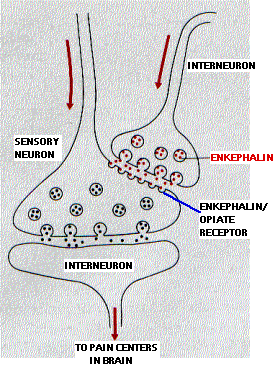| Index to this page |
This page examines the detection of heat, cold, and pain.
Why pain? Because at least some of the receptors of heat and cold — when the stimulus exceeds a certain threshold — transmit signals that the brain interprets as pain.
Few, if any, of the receptors of heat, cold, and pain are specialized transducers (in the way that, for example, the Pacinian corpuscle is). Rather they are sensory neurons whose plasma membrane contains transmembrane proteins that are ion channels that open in response to particular stimuli. A single neuron may contain several types of these ion channels and thus be able to respond to several types of stimuli. Like all sensory spinal neurons, their axons travel to a dorsal root ganglion of the spinal cord, where their cell bodies reside, and then on in to the gray matter of the spinal cord. [View]
Three types of sensory neurons are found in the skin.
| Link to a discussion of the role of myelin in speeding the conduction of nerve impulses. |
Knockout mice lacking the TRPV1 receptor not only do not avoid water with capsaicin in it but have a diminished response to heat and to substances that normal elicit itching.
A single point mutation abolishes the ability of the TRPV1 receptors in the Chinese tree shrew, Tupaia belangeri chinensis, to bind to and thus be activated by capsaicin and related molecules. So the tree shrews eat hot chili peppers and other spicy plants that most mammals avoid.
Birds also have TRPV1 receptors. Theirs also respond to heat (and acids), but because of two point mutations they do not respond to capsaicin. This explains why birds happily eat chili peppers (and so disperse their seeds).
The vampire bat, Desmodus rotundus, expresses normal TRPV1 receptors in the sensory neurons leading to the dorsal root ganglia, and these respond normally to painful heat (> 43°C). However, these bats express a shortened version of TRPV1 (produced by alternative splicing) in their trigeminal nerves that run from the bat's upper lip and nose. The shortened receptors respond to a lower temperature (~30°C) enabling the bats to detect the warmth radiating from the skin of their victims.
Another heat-sensitive ion channel designated TRPA1 is found in pit vipers like rattlesnakes. These cold-blooded animals detect warm-blooded prey using temperature-sensitive neurons at the base of pits in their head. The neurons contain TRPA1 channels that open wide when radiant heat entering the pit raises their temperature above 27°C.
TRPM8 is an ion channel that admits Ca2+ and Na+ in response to moderate cold (10–25°C) or menthol (the ingredient that gives mint its "cool" touch and taste). Knockout mice lacking the gene encoding the TRPM8 receptor do not avoid cold places as normal mice do.
When sensory nerve fibers are exposed to extremes, they signal pain. Pain receptors are also called nociceptors.
All the neurons in the skin are part of the sensory-somatic branch of the peripheral nervous system. Their axons pass into the dorsal root ganglion, where their cell body is located, and then on in to the gray matter of the spinal cord where they synapse with interneurons. [View]
Several different neurotransmitters have been implicated in pain pathways. Three of them:
Inflammation is caused by tissue damage and, among other things, causes pain. Damaged tissue releases prostaglandins and these are potent triggers of pain.
Prostaglandins are 20-carbon organic acids synthesized from unsaturated fatty acids.| Link to illustrated discussion. |

Opioids are extremely effective pain killers but are also addictive so their use is surrounded by controversy and regulation.
Some examples:The two enkephalins are released at synapses on neurons involved in transmitting pain signals back to the brain. Instead of synapsing with a dendrite or cell body, the enkephalin synapse occurs close to the terminal of a pain-signaling neuron. The enkephalins hyperpolarize the presynaptic membrane thus inhibiting it from transmitting these pain signals.
The drawing shows how this mechanism might work. The activation of enkephalin synapses suppresses the release of the neurotransmitter (substance P) used by the sensory neurons involved in the perception of chronic and/or intense pain.
The ability to perceive pain is vital. However, faced with massive, chronic, intractable pain, it makes sense to have a system that decreases its own sensitivity. Enkephalin synapses provide this intrinsic pain-suppressing system.
Morphine and the other opioids bind these same receptors. This makes them excellent pain killers.However, they are also highly addictive.
Research is progressing on coupling substance P to a cytotoxin.
The plan:| Welcome&Next Search |